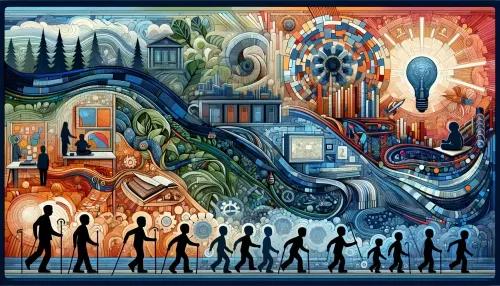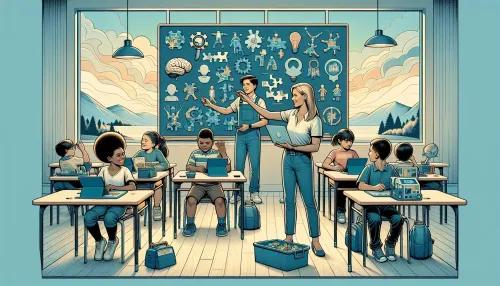
Educational Strategies for Autistic Children: Unlocking Potential in the Classroom

Tailoring Education: Individualized Learning Plans for Autistic Students
In today's diverse classrooms, it's crucial to recognize the unique needs of every student, including those with autism spectrum disorder (ASD). As educators strive to create inclusive environments, tailoring education through Individualized Learning Plans (ILPs) for autistic students has proven to be instrumental in unlocking their potential.
Understanding Individualized Learning Plans (ILPs)
An ILP is a customized roadmap for a student's education that addresses their specific strengths and challenges. For autistic children, the ILP serves as a personalized guide that takes into account their learning styles, sensory sensitivities, communication preferences, and behavioral patterns. By incorporating these individualized strategies into the curriculum, educators can create a supportive and effective learning experience for autistic students.
Implementing ILPs: A Collaborative Approach
Developing an ILP involves collaboration among educators, special education professionals, parents, and the student. This comprehensive approach ensures that the ILP accurately reflects the student's needs and sets realistic learning goals. By fostering open communication and active participation from all stakeholders, the ILP becomes a dynamic tool that adapts to the evolving needs of the autistic student.
The Impact of ILPs on Student Success
Research has consistently demonstrated the positive impact of ILPs on the academic and social development of autistic children. By tailoring education to their unique abilities and challenges, ILPs empower students to make meaningful progress in their learning journey. Additionally, ILPs provide a framework for measuring and assessing the student's growth, allowing educators to continuously refine and optimize their teaching approach.
Creating Sensory-Friendly Classrooms: Enhancing Learning Environments
Sensory-friendly classrooms play a pivotal role in optimizing the educational experience for autistic children. Understanding and accommodating their sensory needs can significantly enhance their comfort, focus, and participation in the learning process.
Sensory Considerations in Classroom Design
Designing a sensory-friendly classroom involves thoughtful consideration of lighting, acoustics, and spatial organization. By minimizing sensory distractions and creating comfortable spaces, educators can mitigate potential triggers for autistic students, promoting a conducive learning atmosphere.
Multisensory Learning Materials
Utilizing multisensory learning materials can further enrich the educational experience for autistic children. Incorporating visual, auditory, and tactile elements into teaching materials facilitates engagement and comprehension, catering to the diverse sensory preferences of students on the autism spectrum.
Supporting Sensory Regulation
Recognizing the individual sensory profiles of autistic students is imperative for promoting their self-regulation in the classroom. Implementing sensory breaks, providing sensory tools, and offering quiet zones enable students to manage their sensory input, fostering a calmer and more focused learning environment.
The Role of Assistive Technology: Tools for Accessibility and Inclusion
In the digital age, assistive technology presents invaluable opportunities to support the diverse learning needs of autistic children. From communication aids to organizational tools, the integration of assistive technology fosters accessibility and inclusion in educational settings.
Augmentative and Alternative Communication (AAC) Devices
AAC devices empower nonverbal or minimally verbal autistic students to express themselves and engage in classroom interactions. By leveraging AAC apps, speech-generating devices, and picture communication systems, educators can facilitate meaningful communication for students with communication challenges.
Personalized Learning Apps
The availability of personalized learning apps caters to the individualized educational requirements of autistic learners. These apps offer interactive, tailored content that aligns with the student's interests and abilities, promoting self-directed learning and skill development.
Digital Organizational Tools
Assistive technology extends to organizational aids that enhance the executive functioning skills of autistic students. From visual schedules to task management apps, these tools support cognitive organization and time management, empowering students to navigate their academic responsibilities more effectively.
Social Skills Development: Nurturing Interpersonal Growth in Autistic Students
Effective social skills development is integral to the holistic education of autistic children. By providing targeted interventions and creating supportive social learning opportunities, educators can cultivate meaningful interpersonal growth in their students.
Social Skills Instruction
Structured social skills instruction equips autistic students with essential communication, collaboration, and self-regulation skills. Through role-playing, social stories, and explicit teaching of social norms, educators can facilitate the gradual acquisition of social competencies in a supportive and understanding environment.
Peer-Mediated Interventions
Engaging peers as social proponents offers autistic students the opportunity to practice social skills in authentic social contexts. Peer-mediated interventions foster empathy, patience, and inclusivity among classmates while providing autistic students with valuable social interaction experiences.
Community Engagement Initiatives
Collaborating with the local community and organizing inclusive events can promote social inclusion and acceptance of autistic students. By creating opportunities for shared experiences and social participation, educators contribute to the broader societal understanding and appreciation of neurodiversity.
Building Teacher-Parent Partnerships: Collaborative Approaches for Student Success
A strong partnership between teachers and parents is pivotal in ensuring the holistic development and academic progress of autistic students. Collaborative communication and coordinated efforts establish a supportive network that nurtures the well-being and educational journey of the student.
Open and Inclusive Communication Channels
Establishing open lines of communication between teachers and parents fosters a shared understanding of the student's needs, progress, and challenges. Regular updates, feedback exchanges, and collaborative decision-making create a unified support system that aligns the home and school environments.
Parental Involvement in Educational Planning
Involving parents in the educational planning process reinforces the collaborative nature of student support. Seeking parental input and insights regarding the student's strengths, interests, and preferences enables educators to tailor instructional approaches and interventions more effectively.
Resource Sharing and Support Networks
Encouraging the sharing of resources, strategies, and community support networks creates a mutually beneficial environment for teachers and parents. This collaborative approach empowers both parties with valuable insights and practical tools to enhance the educational experience of autistic students.
Inclusive Education: Fostering Understanding and Appreciation in School Settings
Fostering an inclusive educational environment goes beyond accommodating the needs of autistic children; it entails cultivating a culture of understanding, empathy, and appreciation for neurodiversity within the school community.
Promoting Neurodiversity Awareness
Educating students, educators, and staff about neurodiversity contributes to a more inclusive and empathetic school culture. By promoting awareness of autism and other neurological differences, schools can foster a more accepting and supportive environment for autistic students and their peers.
Anti-Bullying Initiatives
Creating a zero-tolerance policy for bullying and implementing targeted anti-bullying initiatives protects autistic students from social exclusion and fosters a safe and nurturing school environment. Through education and advocacy, schools can promote a culture of kindness, respect, and acceptance for all students.
Celebrating Neurodiversity
Organizing events, activities, and initiatives that celebrate neurodiversity encourages the recognition and celebration of differences within the school community. By showcasing the diverse strengths and talents of autistic students, schools instill a sense of pride and belonging among neurodiverse learners.
In conclusion, by implementing tailored educational strategies, fostering collaborative partnerships, and promoting inclusivity, educators can create enriching and supportive learning environments for autistic children. Through continuous advocacy and dedication to personalized learning, we can collectively contribute to unlocking the potential of every student, ensuring that inclusive education becomes a cornerstone of our educational ethos at HorizonsMind Blog.


